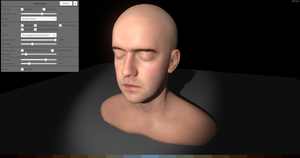Information
- Publication Type: Bachelor Thesis
- Workgroup(s)/Project(s):
- Date: October 2018
- Date (Start): February 2018
- Date (End): 18. October 2018
- Matrikelnummer: 01527007
- First Supervisor:
- Keywords: subsurface scattering, virtual reality
Abstract
Subsurface Scattering is a physical phenomenon that appears in many materials but is most notable for human skin. Current research makes it possible to calculate the local scattering of light inside a translucent medium around the point of entry with a convolution of a separable filter in screen-space. This thesis tries to evaluate this technique by Jimenez et al. for stereoscopic rendering and how it can be implemented for the currently popular game engine Unity. Unity offers support for VR applications and allows the implementation of post-processing effects and other techniques that rely on shaders. The implemented Subsurface Scattering method is combined with an approach for translucency and a physically based specular model. In the developed application the effects can be observed with and without VR and important parameters can be changed by the user. The performance and visual quality are reviewed with respect to the viability of the effects in Unity, stereoscopic rendering and frame rate. The latter is especially important in VR applications to deliver a comfortable interactive experience.Implementation https://drive.google.com/file/d/19cWkXh19uDCIa6Mcu3qy1UeIxYlOmjJA/view?usp=sharing
Additional Files and Images
Weblinks
No further information available.BibTeX
@bachelorsthesis{Fischer-2018-sssvr,
title = "Subsurface Scattering in VR",
author = "Lukas Fischer",
year = "2018",
abstract = "Subsurface Scattering is a physical phenomenon that appears
in many materials but is most notable for human skin.
Current research makes it possible to calculate the local
scattering of light inside a translucent medium around the
point of entry with a convolution of a separable filter in
screen-space. This thesis tries to evaluate this technique
by Jimenez et al. for stereoscopic rendering and how it can
be implemented for the currently popular game engine Unity.
Unity offers support for VR applications and allows the
implementation of post-processing effects and other
techniques that rely on shaders. The implemented Subsurface
Scattering method is combined with an approach for
translucency and a physically based specular model. In the
developed application the effects can be observed with and
without VR and important parameters can be changed by the
user. The performance and visual quality are reviewed with
respect to the viability of the effects in Unity,
stereoscopic rendering and frame rate. The latter is
especially important in VR applications to deliver a
comfortable interactive experience. Implementation
https://drive.google.com/file/d/19cWkXh19uDCIa6Mcu3qy1UeIxYlOmjJA/view?usp=sharing
",
month = oct,
address = "Favoritenstrasse 9-11/E193-02, A-1040 Vienna, Austria",
school = "Institute of Computer Graphics and Algorithms, Vienna
University of Technology ",
keywords = "subsurface scattering, virtual reality",
URL = "https://www.cg.tuwien.ac.at/research/publications/2018/Fischer-2018-sssvr/",
}

 image
image

